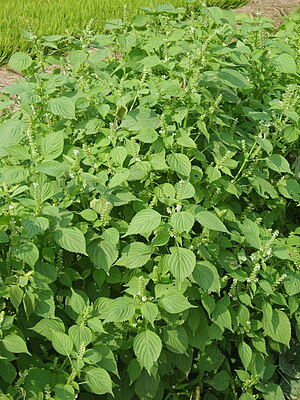Note: This is a project under development. The articles on this wiki are just being initiated and broadly incomplete. You can Help creating new pages.
Perilla frutescens - Perilla
Deulkkae is an annual plant native to Southeast Asia and Indian highlands and grown in Korean peninsula, Southern China and India. The plant was introduced into Korea before Unified Silla era, when it was widely cultivated.
Contents
- 1 Uses
- 2 Parts Used
- 3 Chemical Composition
- 4 Common names
- 5 Properties
- 6 Habit
- 7 Identification
- 8 List of Ayurvedic medicine in which the herb is used
- 9 Where to get the saplings
- 10 Mode of Propagation
- 11 How to plant/cultivate
- 12 Commonly seen growing in areas
- 13 Photo Gallery
- 14 References
- 15 External Links
Uses
Astama, Cough, Colds, Chills, Nausea, Abdominal pain, Food poisoning, Diarrhea.
Parts Used
Chemical Composition
Research has isolated such constituents as apigenin, Ascorbic-acid, beta-carotene, caffeic-acid, citral, dillapiol, elemicin, limonene, luteolin, myristicin, perillaldehyde, protocatechuic-acid, quercetin, rosmarinic-acid.[1]
Common names
| Language | Common name |
|---|---|
| Kannada | |
| Hindi | |
| Malayalam | |
| Tamil | |
| Telugu | |
| Marathi | NA |
| Gujarathi | NA |
| Punjabi | NA |
| Kashmiri | NA |
| Sanskrit | |
| English | Beefsteak mint |
Properties
Reference: Dravya - Substance, Rasa - Taste, Guna - Qualities, Veerya - Potency, Vipaka - Post-digesion effect, Karma - Pharmacological activity, Prabhava - Therepeutics.
Dravya
Rasa
Tikta (Bitter), Kashaya (Astringent)
Guna
Laghu (Light), Snigda (unctuous)
Veerya
Ushna (Hot)
Vipaka
Katu (Pungent)
Karma
Kapha, Pitta, Vata
Prabhava
Habit
Identification
Leaf
| Kind | Shape | Feature |
|---|---|---|
| Simple | Opposite | 7–12 centimetres (2.8–4.7 in) long and 5–8 centimetres (2.0–3.1 in) wide, with an broad oval shape, pointy ends, serrated(saw-toothed) margins, and long leafstalks |
Flower
| Type | Size | Color and composition | Stamen | More information |
|---|---|---|---|---|
| Unisexual | The calyx, 3–4 millimetres (0.12–0.16 in) long | Yellow | Four stamens | The flowers bloom on racemes at the end of branches and the main stalk in August and September |
Fruit
| Type | Size | Mass | Appearance | Seeds | More information |
|---|---|---|---|---|---|
| 7–10 mm (0.28–0.4 in.) long pome | Clearly grooved lengthwise, Lowest hooked hairs aligned towards crown | With hooked hairs | {{{6}}} |
Other features
List of Ayurvedic medicine in which the herb is used
Where to get the saplings
Mode of Propagation
How to plant/cultivate
The plant was introduced into Korea before the Unified Silla era, when it started to be widely cultivated.In its natural state, the yield of perilla is not high.[2]
Commonly seen growing in areas
Pastures, Dry land, Along roadsides.
Photo Gallery
References
External Links
- Ayurvedic Herbs known to be helpful to treat Astama
- Ayurvedic Herbs known to be helpful to treat Cough
- Ayurvedic Herbs known to be helpful to treat Colds
- Ayurvedic Herbs known to be helpful to treat Chills
- Ayurvedic Herbs known to be helpful to treat Nausea
- Ayurvedic Herbs known to be helpful to treat Abdominal pain
- Ayurvedic Herbs known to be helpful to treat Food poisoning
- Ayurvedic Herbs known to be helpful to treat Diarrhea
- Herbs with Leaves used in medicine
- Herbs with Stems used in medicine
- Herbs with common name in English
- Habit - perennial plant
- Index of Plants which can be propagated by Seeds
- Index of Plants which can be propagated by Cuttings
- Herbs that are commonly seen in the region of Pastures
- Herbs that are commonly seen in the region of Dry land
- Herbs that are commonly seen in the region of Along roadsides
- Herbs
- Lamiaceae



